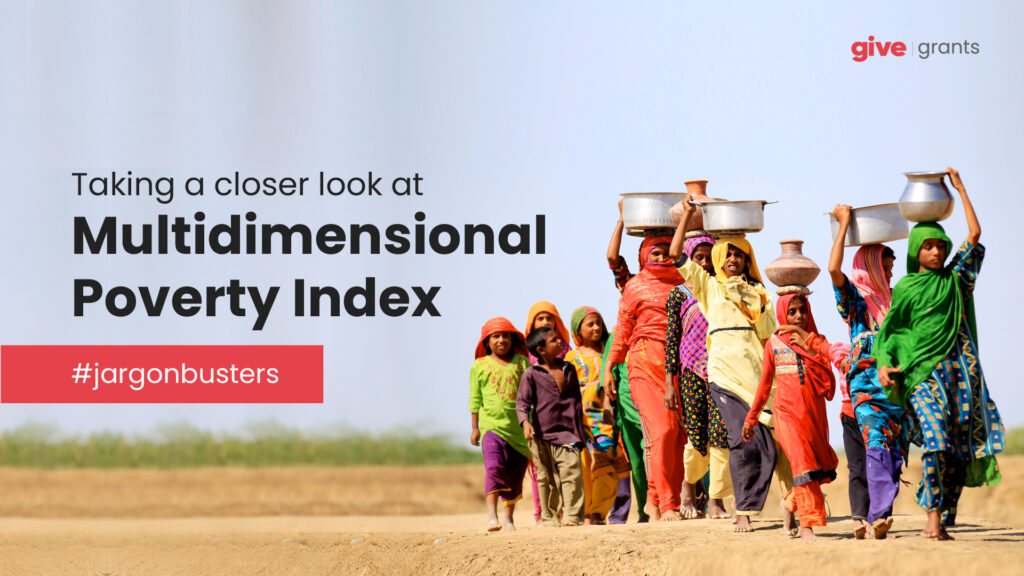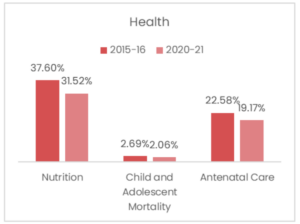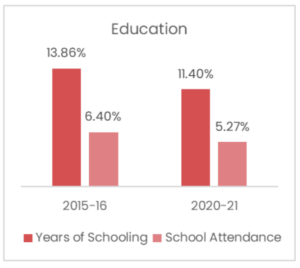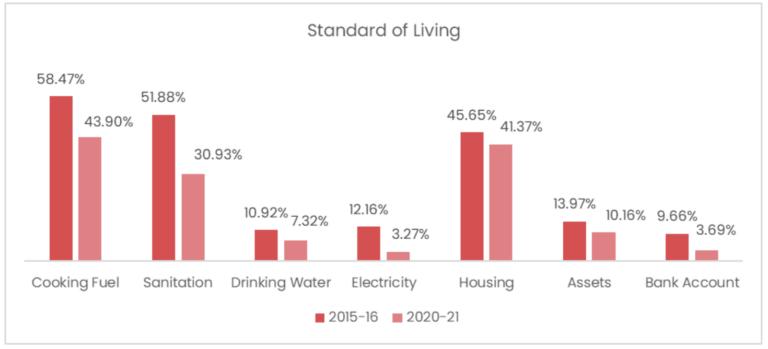Understanding the Multidimensional Poverty Index

India has reported a Poverty Headcount reduction between 2016 and 2021 from 24.85% to 14.96% amounting to 13.5 Cr people having overcome poverty (NMPI Progress Review 2023). This is the first time India has reported on the progress made on a poverty index that is not income-based.
A vast majority of CSR programs focus on communities that are experiencing poverty and deprivation of some nature and as a result, have contributed to their journey out of poverty. Multidimensional Poverty Index by Niti Aayog publishes district-level data recording these successes as well as the next set of challenges awaiting the attention of CSR professionals.
Multidimensional Poverty
Among the 17 Sustainable Development Goals (SDGs) established by the Resolution of the United Nations General Assembly on 25 September 2015, SDG 1 – “End poverty in all its forms everywhere” underlines the multidimensional character of poverty. The Multidimensional Poverty Index (MPI) is a tool used to measure poverty through various factors, including health, education, and living standards. It provides a comprehensive understanding of poverty and allows for targeted interventions.
The multidimensionality of poverty has been in discussion as a theoretical concept for the better part of the 20th century. Amartya Sen’s Nobel Prize (Economics) winning research on Poverty, inequality, and capabilities approach has provided the theoretical underpinnings for Multidimensional Poverty (Development as Freedom, 1999). Whereas, the measurement methods were developed by the Oxford Poverty and Human Development Initiative (OPHI) in 2011 (Policy and Alkin Foster Method, 2011). [Details in annexure]
National Multidimensional Poverty Index
In 2021, under the leadership of Niti Aayog, India launched the Multidimensional Poverty Index (MPI) with the technical support of the United Nations Development Programme (UNDP) and Oxford Poverty and Human Development Initiative (OPHI) and in partnership with eleven key ministries (NMPI – Baseline Report 2015-16| Pub 2021). This exercise was part of the Global Indices for Reforms and Growth (GIRG) mandate of the Government of India to monitor, analyze, and evaluate 29 global indices to improve India’s position in global rankings. MPI has 3 primary categories, health, education, and standard of living. Each one of the categories is further bifurcated amounting to a total of 12 indicators.

The measurement tool identifies people as poor or not poor based on a dual-cutoff counting method. The first cut-off within each component indicator is applied to determine which household is “deprived” in that indicator. The information across all indicators is then aggregated to arrive at a deprivation score for each household. The second cut-off is then applied to identify the multidimensionally poor households.
The 2021 launch included a baseline of the National Multidimensional Poverty headcount derived from the National Family Health Survey 2015-16 (NFHS – 4). A review exercise was concluded in 2021, covering a 5-year window. As the exercise continues, the index will provide policymakers with valuable insights into the efficacy of poverty alleviation strategies, and specific challenge areas/ trends at the district level which is the smallest unit of policymaking.
MDP Indicators for India [Data from (NMPI Progress Review 2023)]

Nutrition – A household is considered deprived if any child between the ages of 0 to 59 months, a woman between the ages of 15 to 49 years, or a man between the ages of 15 to 54 years -for whom nutritional information is available- is found to be undernourished. This component contributes to nearly one-third of the multidimensional poverty in India. As the categorization is defined at a household level, even if a single member of the household is identified as undernourished, the entire household is accounted for as deprived of nutrition. The understanding is that the factors causing one household member the suffer undernourishment will have a direct or indirect effect on other members of the same household.
Child and Adolescent Mortality – A household is deprived if any child or adolescent under 18 years of age has died in the household in the five years preceding the survey. The death of a child or adolescent in a household indicates many aspects of deprivation like lack of healthcare access, the propensity of infectious diseases, malnutrition, iron-deficiency anemia as well as an unsafe environment that can contribute to child and adolescent mortality. A loss of this nature could also result in deprivation from the loss of a potential earning member or caregiver for the family.
Antenatal Care – A household is deprived if any woman in the household who has given birth in the 5 years preceding the survey has not received at least 4 antenatal care visits for the most recent birth or has not received assistance from trained skilled medical personnel during the most recent childbirth. The WHO’s four-visit ANC model provides a structured framework for healthcare providers to monitor maternal health, and fetal development, and intervene promptly when necessary. ANC plays a pivotal role in identifying and managing complications during pregnancy, thereby reducing maternal and neonatal mortality rates.

Years of schooling – A household is deprived if not even one member of the household aged 10 years or older has completed six years of schooling. A household with at least one member with six years of schooling is considered non-deprived, even though each member may not have attended school. The assumption is the future ability to enter high-paying employment or improvement in social standing because of one member receiving education.
School attendance – A household is deprived if any school-aged child is not attending school up to the age at which he/she would complete class 8. A child not attending school is of consequence both the present set of deprivations experienced by the household as well as the possible future deprivations that would result from lack of education.

Cooking Fuel – A household is deprived if the primary source of cooking fuel is dung, crops, shrubs, wood, charcoal, or coal. Simply the presence of electricity, LPG/natural gas, and biogas as cooking fuel in the household is not enough to warrant a “not deprived” status. The household must also be utilizing the improved/safe source of cooking fuel as their primary source of cooking fuel.
Sanitation – The household has unimproved or no sanitation facility or it is improved but shared with other households. The expectation is to have access to an improved and independent sanitation facility.’
Drinking Water – A household is deprived if it does not have access to improved drinking water or safe drinking water is more than a 30-minute walk from home (as a round trip). Safe or improved sources of drinking water include piped water supply, public taps, standpipes, tube wells, boreholes, protected dug wells and springs, rainwater, and community reverse osmosis (RO) plants. At least one of them should be available within a 30-minute round trip.
Electricity – A household is deprived if it has no electricity. Electricity is treated as an essential service and forms a critical input for availing other services/information
Housing – A household is deprived if it has inadequate housing: the floor is made of natural materials, or the roof or walls are made of rudimentary materials.
Assets – The household is deprived if it does not own more than one of these assets: radio, TV, telephone, computer, animal cart, bicycle, motorbike, or refrigerator; and does not own a car or truck,
Bank Account – No household member has a bank account or a post office account. Other than access to institutionalized credit and saving instruments, financial inclusion in a household by having a bank account is critical for availing the benefits of government programs and entitlements aimed at reducing poverty, increasing access to education, and creating livelihoods via direct benefit transfers.
Appendix
Capabilities Approach
Amartya Sen’s Capabilities Approach emphasizes that people’s well-being should be assessed based on their opportunities and freedoms to live the kind of life they value. This approach considers a wide range of factors that influence people’s ability to live fulfilling lives, including education, health, political participation, social relationships, and access to resources. He further defines deprivation as the lack of basic capabilities necessary for people to live a fulfilling life. Deprivation is not merely the absence of material goods or income; it encompasses the inability to pursue a range of valuable opportunities, thus emphasizing the multidimensional nature of deprivation, recognizing that individuals can be deprived in various ways beyond just economic poverty.
The Alkire-Foster Method for Poverty Measurement
The Alkire-Foster (AF) method is a flexible technique for measuring poverty or well-being. It can incorporate different dimensions and indicators to create national, regional, or international measures of poverty or well-being. It can be used to monitor the effectiveness of programs over time. The method assists the Program or Policy design community in effectively allocating resources; designing better-targeted approaches, identifying interconnection among deprivations, demonstrating impact over time, and most importantly; working in conjunction with other relevant metrics; interconnection among deprivations, demonstrating impact over time and most importantly, working in conjunction with other relevant metrics.